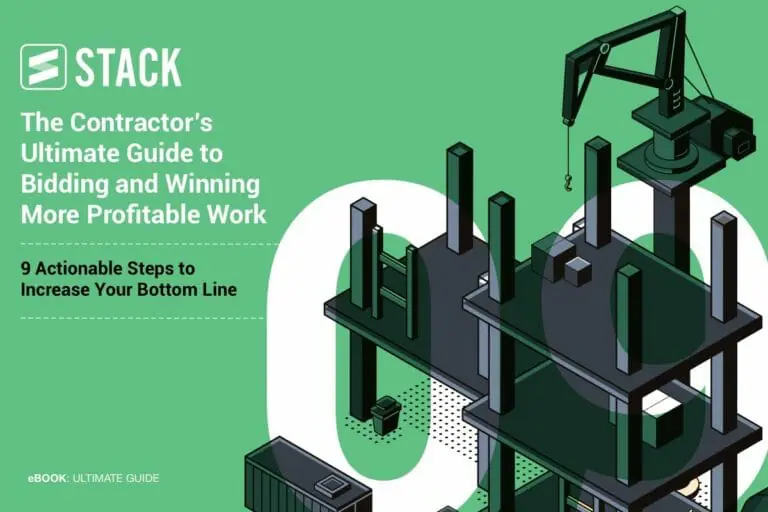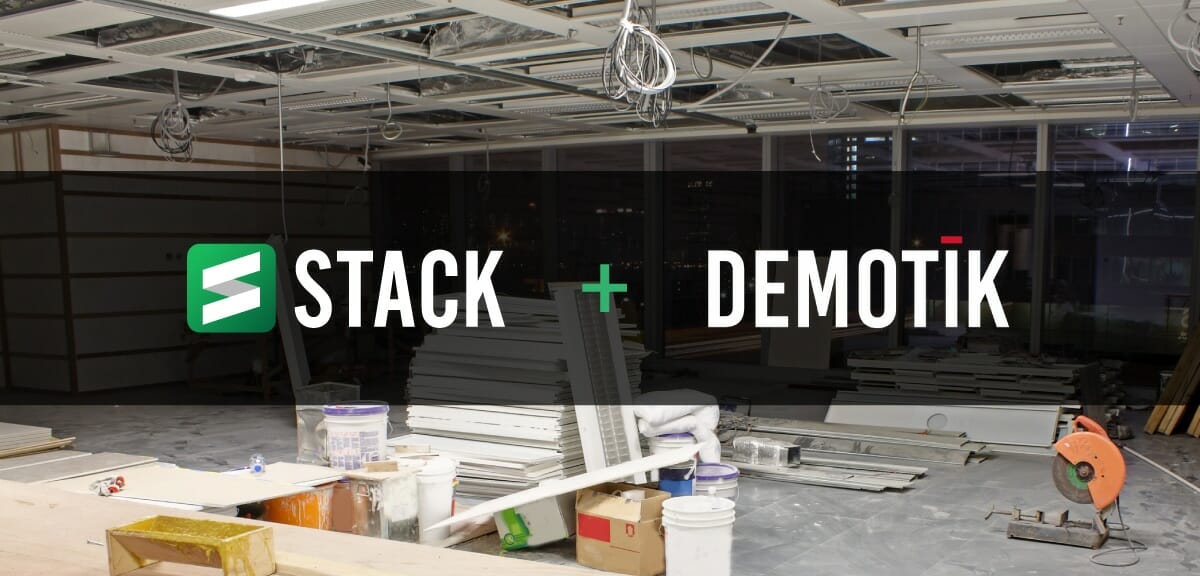9 Actionable Steps to Increase Your Bottom Line

It’s every contractor’s goal to find more of the right kinds of projects, submit more bids in less time, and win more profitable work. Sometimes it seems unattainable because there’s just not enough time in each day – but the top contractors have found a way. You can too, by taking a step back and creating a detailed strategy for your business.
Starting before you even look for projects and ending after the job wraps up, if you follow this process, you’ll be setting yourself up for success. Here are the 9 steps to take on your way to more bids, more wins, and more profit.
1. Determine your niche.
First things first, take inventory of your past jobs. Identify the ones that were relatively smooth sailing and that brought in the most profit, as well as the ones that weren’t worth it in the end. What threads do they have in common? Think about:
– Type of structure: Are you really efficient at medical complexes? Schools? Restaurants? Office buildings?
– GC/owner: Are there particular stakeholders that were ideal to work with? Did you sync with them easily and find the relationship mutually beneficial?
– Travel/location: Did you take any jobs that promised high profit margins but due to crew travel expenses ended up being too costly?
– Specialization: Does your crew have a lot of experience with environmentally friendly materials and specs? Are your employees masters at waterproofing and coatings? Are you experts at hillside foundations or custom metalwork?
As you start to spot patterns, you can narrow down your particular areas of specialty.
Maybe you’ll learn that jobs more than 75 miles from your headquarters are never worth the extra travel hassle, and you can immediately ignore any projects outside that radius.
Or, you might be surprised to discover that your crew is especially talented at navigating the project phasing that comes along with occupied medical facility construction.
Whatever your company’s specific strengths are, take advantage of them by seeking out similar work as your highest priority for bidding. These are the jobs that are worth spending the extra time double checking your estimates, conducting site visits, and following up with owners and GCs because you’re confident you’ll have a strong ROI on your preconstruction efforts.
**TIP: Once you’ve identified your business’s core strengths, make them public. Create a landing page for each specialty on your website, listing out what differentiates you. Consider other marketing materials like brochures, billboards, and digital ads to help you spread the word.**
2. Develop tactics for diversification.
After you’ve identified your ideal project type, your next step is to find ways to expand upon your specialties. This is important because you might find that you’re the go-to contractor for your niche, but you still have capacity because your business has grown so much. If that’s the case, great news!
But there are also likely to be times in which projects in your specialty area are hard to come by, so you’ll need to have backup plans. Consider:
– What type of work is adjacent to your specialty?
– What are the recent building trends that you could become adept at?
– How is the economy affecting certain industries? Are there some that seem to be rising to the top that you could target?
– What are your crew members’ backgrounds? Does someone have experience in another area that you could shift toward?
As you begin to do more work in these newer areas and grow your business, they will become additional specialties, allowing you to expand your niche. As you do so, repeat the process, so you always have something in your back pocket in case of market downturns or abrupt industry shifts.
3. Stop bidding on jobs that aren't worth your time.
It can be difficult to resist the temptation to bid on a high number of available jobs in the hopes of increasing your chances of winning some. But now that you’ve completed a close analysis of which jobs have the highest payout, it’s a no brainer. Don’t bid on jobs that are:
– Farther away than your target distance
– Out of the scope of your niche or expansion plan
– On schedules that are too tight for your crew
– Unclear on specs that will have a significant impact on your trade
– More complex than your team can handle
– Will not give you the profit margin you need*
*The exception to this rule is a case in which you’re deliberately trying to break into a new area of expertise to expand your niche, and you have a solid cushion from previous successful jobs. Then you might intentionally reduce your margin so you come in with the lowest bid in order to increase your odds of winning the job.
This is a fine tactic for those first few forays into new specializations, but do make sure that as you gain a reputation for those new areas, you increase your prices accordingly.
4. Maintain a rock-solid crew.
Employee turnover costs US businesses $1 trillion every year. And with shortages of skilled laborers, effects of turnover can be especially tough on construction contractors. Not only do you face costs associated with hiring new workers, but you also face the risk of being shorthanded on important jobs or being forced to hire less qualified personnel.
These costs add up in more than just your payroll – if your work quality suffers due to employee turnover, you can lose your reputation among GCs and find yourself losing out on jobs.
Avoid this worst-case scenario by taking care of good workers when you find them. Retain talented employees by:
– Offering competitive pay and benefits
– Sponsoring training or apprenticeships for workers who want to develop their skills
– Giving referral bonuses for recommendations from employees’ networks
– Being as flexible as possible in the face of personal emergencies
– Having clear and reasonable expectations
– Providing opportunities for team building
– Being open to employee ideas, needs and suggestions, such as updated jobsite processes, new software, or outdated company policy
A crew that can joke together will have each other’s backs and be prepared to get the job done, so even when you’re on tight deadlines, try to stay upbeat with your staff and not take things too seriously. Make your company a place where your employees want to come to work.
5. Audit your preconstruction tools and process.
The adage “profits are made in the preconstruction phase” exists for a reason. If you start out on the wrong foot before work even begins on a project, you’re setting yourself up for a struggle to break even.
One surefire way to get ahead is to streamline the way you handle preconstruction.
Start by looking at how you do takeoffs.
If you perform takeoffs on printed blueprints, consider:
– How much time do you spend on manual measuring?
– How many jobs do you pass up because you can’t meet the bid deadline?
– What happens if plans are lost or damaged?
– Does your team spend time searching for blueprints in a messy plan room?
– What are the costs associated with printing?
– Are there delays due to waiting for availability at the print shop?
– Is work duplicated when change orders are received?
– How do you communicate and collaborate with team members in the field?
If you use material takeoff software, are you using the most efficient option? Evaluate:
– Are you able to store project documents with plans for easy access and organization?
– Is the program interface simple to use?
– Does the software have a search function and/or autonaming feature, or do you spend time digitally paging through plans for what you need?
– What types of collaboration does the software enable? Can you share takeoffs with others in the field, or with suppliers and vendors?
– Are updates made in real-time within the platform, or do you need to download and upload locally saved files?
– Can you quickly identify plan changes when addenda come through?
– Can you make changes to a takeoff easily?
– Does the platform allow you to generate estimates and proposals from your takeoffs, or do you need to export data to other systems for those tasks?
If your current takeoff process isn’t up to par, take steps to improve your tools. When your takeoffs are faster, your estimating team can be more strategic both in choosing jobs to bid and in submitting high-quality proposals.
Ready to speed up your takeoff? Create a free STACK account.
**TIP: Not all jobs are worth the effort to bid on. With the right tools, you can evaluate projects faster and that will allow you to pass on the projects that aren’t right for your company. Ambiguity in drawings that the client can’t or won’t address? Pass. Job too far away geographically? Pass. Project outside the scope of your niche? Pass. Find tips on red flags to look out for.**
Examine your estimates.
Once your takeoffs are faster, you can really take your time getting your estimates perfected. To reduce the likelihood of introducing user errors – like typos, misplaced decimal points, or skipped lines – into your data, choose a technology platform that allows you to do your takeoffs and estimates in the same place. (This also reduces redundancies in tool costs.)
Use items and assemblies to be sure your takeoff quantities are completely accurate in your estimate, and then get even more granular with other aspects of the work. Dig deep into:
– Overhead: What are your annual overhead costs? Account for a portion of them in each project estimate.
– Waste: Factor in waste not only for scrapped materials but also lost time due to crew absences and injuries, and late supplies.
– Indirect costs: Will the project require equipment rentals, waste containers, or other non-measured costs?
– Profit: Don’t forget to add profit into your estimates for your business! A tool that will break down project costs vs profit will help you see what a reasonable profit margin for each job is.
6. Establish positive relationships with others in the industry.
Construction is an industry built on networking. Making yourself known can make a big difference in getting ahead.
GCs and Owners
Attend trade shows and purchase memberships to trade associations, join your local chamber of commerce, and be visible in your community. Make a name for yourself by donating some time and labor to local causes, and always have a business card handy. When you do win bids, stay professional and make yourself invaluable to the GC or owner, so they know they can count on your work.
This way you might get direct invitations to bid from GCs who are familiar with your company rather than having to seek out new work.
**TIP: When interacting with a GC for the first time, make a good impression by submitting a professional-looking proposal that includes not only your thorough estimate but also your company logo and standard legal terms and conditions. A comprehensive takeoff and estimating platform will allow you to export your bid-ready proposal directly from the software.**
Other Subcontractors
Connect with other subcontractors who work in different trades so you can mutually recommend each other. Having a solid network of peers allows you to offer more value on projects where GCs are looking for reliable subs. You can save the day by suggesting a good contractor to complement your work – and others can have your business name at the ready when they encounter the same situation.
It’s a win-win for subs who don’t consider each other competitors, so be sure to keep in contact with those you know in other trades.
Suppliers and Vendors
Start viewing your vendors more as partners instead of thinking of the relationships as purely transactional. If you can find suppliers you trust, stick with them and build those connections. You can send your takeoffs to them along with your quote requests for fully accurate orders and keep in touch with them about what’s new in the market as far as materials go.
Yes, they’re looking to make a sale, but it’s also in their best interest to help educate you as a customer and keep your business for the long term. They want you to buy, so they can be a great source of training on the latest materials that can help distinguish you to clients. Take advantage of their resources.
**TIP: As your company is growing, cash can be tight, and this can sometimes be a source of tension in relationships with suppliers. Solutions exist that can cover that cash flow gap until you’re able to strengthen those relationships – for example, Billd procures materials on your behalf with 120-day repayment terms, helping to establish your credibility with suppliers while freeing up your cash flow for your day-to-day operations.**
7. Choose and recommend materials strategically.
Make yourself known as the contractor who can not only complete the job on time and on budget, but who also is an expert on materials needed for meeting regulations while still providing exceptional service. Understand building codes and stay up-to-date on requirements for things like fire ratings, corrosion-resistant materials, and load and resistance factors for the locations you serve.
Being able to provide recommendations that will increase safety and reduce repairs or legal struggles down the road will go a long way toward building your reputation among GCs and owners.
If you’ve kept up on educating yourself on the latest updates in your trade, you’ll also be able to offer added value in terms of cost reduction, increased efficiency, or more environmentally friendly materials, further establishing your business as the expert in the field.
8. Protect your bottom line with your proposals and contracts.
While everyone hopes for a smooth project with no changes or surprises, those rarely occur. Be ready by planning for contingencies in your documentation. Your contract should specify that material pricing is only guaranteed for the agreed-upon timeframe of the job, and that delays or other changes could cause price increases over the initial estimate.
You should have a process in place for handling any change orders that come in. Address them right away rather than moving forward with the job and pushing the paperwork to the back burner. Use your preconstruction platform to go back to the original plans, overlay the updates, and compare the old takeoff to generate a new price.
The GC or owner should agree to your amended estimate before you complete the work, so that both parties are clear on what’s required and you aren’t left chasing down dollars at the end of the project.
9. Conduct a detailed project review when site work is complete.
When site work ends, many contractors pass the job to the billing department and move on to the next project. They’re busy, and why look at work that’s over rather than focusing on bringing in future revenue?
But this is where the most successful contractors set themselves apart. Taking time out for a project wrap-up lets you identify discrepancies between your original estimate and the project outcome. Analyze:
– How many labor hours did you anticipate you’d need versus how many you actually used?
– Where was there the more material waste than expected?
– Which, if any, supply orders were delayed?
– Were there indirect costs that weren’t planned for?
– How did change orders affect the cost and efficiency of the project?
– What went smoothly, and where in the course of the job were there problems?
By making time to examine these questions, you can adjust your tactics for upcoming work. For example:
– Maybe you need to add a higher percentage of waste into your estimate for the next similar project, or your crew needs more training on how to reduce material waste.
– Maybe you need to find a more reliable supplier partner if material delivery delays negatively affected your ability to complete the work.
– Maybe this type of project requires you to hire added temporary help to get the job done faster.
Anything you learn from past projects should be documented so you can apply it to future work. The more project reviews you conduct, the more patterns you’ll notice, and the more you’ll be able to adapt your preconstruction process to make the entire job more streamlined and more profitable.
**TIP: You can use your end-of-project review to glean insights for marketing purposes as well. Finding trends on low incident reports can lead to emphasizing your stellar safety record, or you can generate statistics on the percentage of jobs you complete on schedule or under budget. Use this data to your advantage by making it public on marketing materials.**
The Bottom Line on Increasing Your Bottom Line
Following these steps will send you in the right direction for a better workflow and more profits. They’re not the end-all, be-all, though, so make sure you’re constantly on the lookout for new ways to improve.
Keep up on the latest developments in construction technology tools, look for strategies to reduce overhead, and stay up-to-date on trade and industry standards.
As long as you’re always looking for ways to increase efficiency in your processes, your business will be in a position for continued growth and success.








